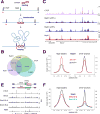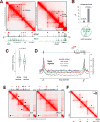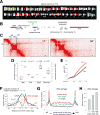The Energetics and Physiological Impact of Cohesin Extrusion
- PMID: 29706548
- PMCID: PMC6065110
- DOI: 10.1016/j.cell.2018.03.072
The Energetics and Physiological Impact of Cohesin Extrusion
Erratum in
-
The Energetics and Physiological Impact of Cohesin Extrusion.Cell. 2018 Sep 20;175(1):292-294. doi: 10.1016/j.cell.2018.09.002. Cell. 2018. PMID: 30241609 Free PMC article. No abstract available.
Abstract
Cohesin extrusion is thought to play a central role in establishing the architecture of mammalian genomes. However, extrusion has not been visualized in vivo, and thus, its functional impact and energetics are unknown. Using ultra-deep Hi-C, we show that loop domains form by a process that requires cohesin ATPases. Once formed, however, loops and compartments are maintained for hours without energy input. Strikingly, without ATP, we observe the emergence of hundreds of CTCF-independent loops that link regulatory DNA. We also identify architectural "stripes," where a loop anchor interacts with entire domains at high frequency. Stripes often tether super-enhancers to cognate promoters, and in B cells, they facilitate Igh transcription and recombination. Stripe anchors represent major hotspots for topoisomerase-mediated lesions, which promote chromosomal translocations and cancer. In plasmacytomas, stripes can deregulate Igh-translocated oncogenes. We propose that higher organisms have coopted cohesin extrusion to enhance transcription and recombination, with implications for tumor development.
Keywords: CTCF; DNA damage; Nipbl; chromosomal translocations; class switching; cohesin; loop extrusion; nuclear architecture; topoisomerase II.
Copyright © 2018 Elsevier Inc. All rights reserved.
Conflict of interest statement
The authors declare no conflicts of interest.
Figures







References
Publication types
MeSH terms
Substances
Grants and funding
- UM1 HG009375/HG/NHGRI NIH HHS/United States
- P30 CA034196/CA/NCI NIH HHS/United States
- U54 DK107967/DK/NIDDK NIH HHS/United States
- R25 HG007631/HG/NHGRI NIH HHS/United States
- T32 GM008294/GM/NIGMS NIH HHS/United States
- P50 HG006193/HG/NHGRI NIH HHS/United States
- R01 CA186714/CA/NCI NIH HHS/United States
- T32 GM008307/GM/NIGMS NIH HHS/United States
- Z01 AR041149/ImNIH/Intramural NIH HHS/United States
- RM1 HG006193/HG/NHGRI NIH HHS/United States
- DP2 OD008540/OD/NIH HHS/United States
- Z01 AR041148/ImNIH/Intramural NIH HHS/United States
LinkOut - more resources
Full Text Sources
Other Literature Sources
Molecular Biology Databases
Research Materials

